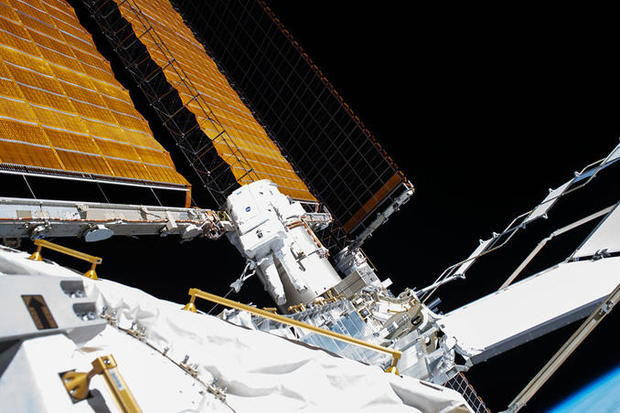Watch a live stream of the spacewalk in the video player above beginning at about 7 a.m. EDT.
Now in the home stretch of a complex, multi-year upgrade, two space station astronauts readied tools and equipment for a spacewalk Thursday — the third of four spacewalks the current crew is carrying out to complete the replacement of aging batteries in the lab’s solar power system.
Station commander Chris Cassidy and astronaut Robert Behnken plan to begin the excursion around 7:35 a.m. EDT, switching their spacesuits to battery power while still inside the Quest airlock. That will officially kick off the sixth spacewalk, or EVA, so far this year. It’s the 11th spacewalk devoted to battery replacement work since 2017.
For identification, Behnken, call sign EV-1, will be wearing a suit with red stripes while Cassidy, EV-1, will use an unmarked suit.
After checking safety tethers, the astronauts planned to head for the far right end of the lab’s power truss to continue work started during spacewalks June 26 and July 1 to replace 12 older nickel-hydrogen batteries at the base of the outboard set of solar arrays with six more powerful lithium-ion power packs.
The space station is equipped with four huge solar wings, two at each end of the power truss, that feed electricity into eight power distribution channels. Twelve nickel-hydrogen batteries at the base of each wing, six per power channel, keep the ISS functioning when it’s in orbital darkness.
Starting in January 2017, astronauts began replacing the old batteries with more powerful lithium-ion units. Because they are more efficient, only six lithium-ion batteries are needed at the base of each solar wing, along with circuit completing adapter plates to take the place of batteries that were removed but not replaced.
During spacewalks in 2017 and 2019, spacewalking astronauts replaced all 24 nickel-hydrogen batteries used by the left and right inboard arrays. The left-side outboard solar wing was upgraded during spacewalks in 2019 and earlier this year, leaving just the right-side outboard set — 12 batteries feeding two power channels — for Cassidy and Behnken.
They completed the battery work for one power channel during their two earlier spacewalks.
During Thursday’s outing, they planned to remove five of the six remaining nickel-hydrogen batteries and to install all three of the remaining lithium-ion units, along with a final three adapter plates. They also planned to install a high-definition camera boom on the power truss.
Two of the new batteries should be connected by the end of the spacewalk. The final new battery will be tied into the power channel next week, after the last nickel-hydrogen battery is removed.
NASA planners originally thought the battery work would take two spacewalks per power channel, but Cassidy and Behnken ran well ahead of schedule during their first two EVAs, leaving time for several other tasks, including installation of a high-definition camera boom Thursday.
During next week’s spacewalk, the astronauts plan to finish the battery work; make preparations for installation of a commercial research airlock; install a tool storage box; and remove two of six no-longer-needed ground-handling fixtures at the base of the solar wings to clear the way for future upgrades.
Assuming the final two spacewalks run exactly six-and-a-half-hours each as planned, Behnken will move up to third on the list of most experienced spacewalkers with 62 hours and 41 minutes of EVA time over 10 outings. Cassidy’s 10-spacewalk mark will stand at 56 hours and 22 minutes, moving him up to eighth in the world.
Cosmonaut Anatoly Solovyev holds the all-time spacewalk record with 78 hours and 21 minutes over 16 EVAs. NASA astronaut Michael Lopez-Alegria is second with 67 hours and 40 minutes over 10 excursions.



